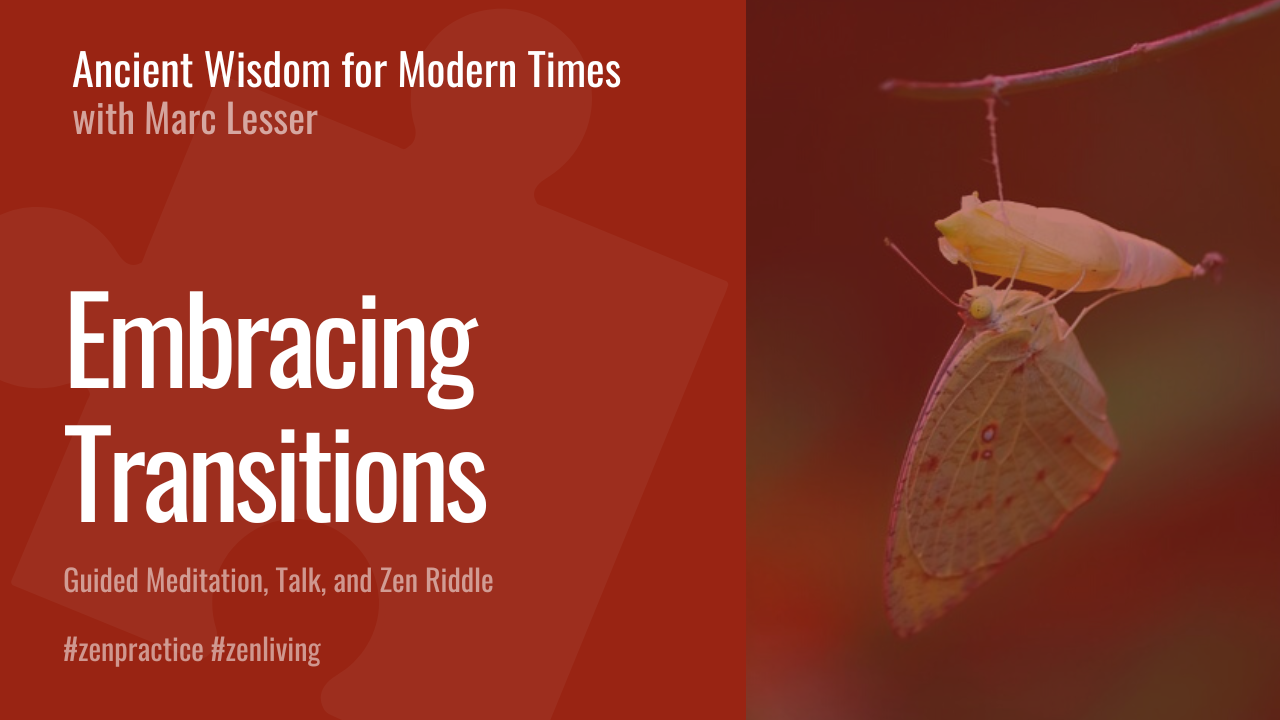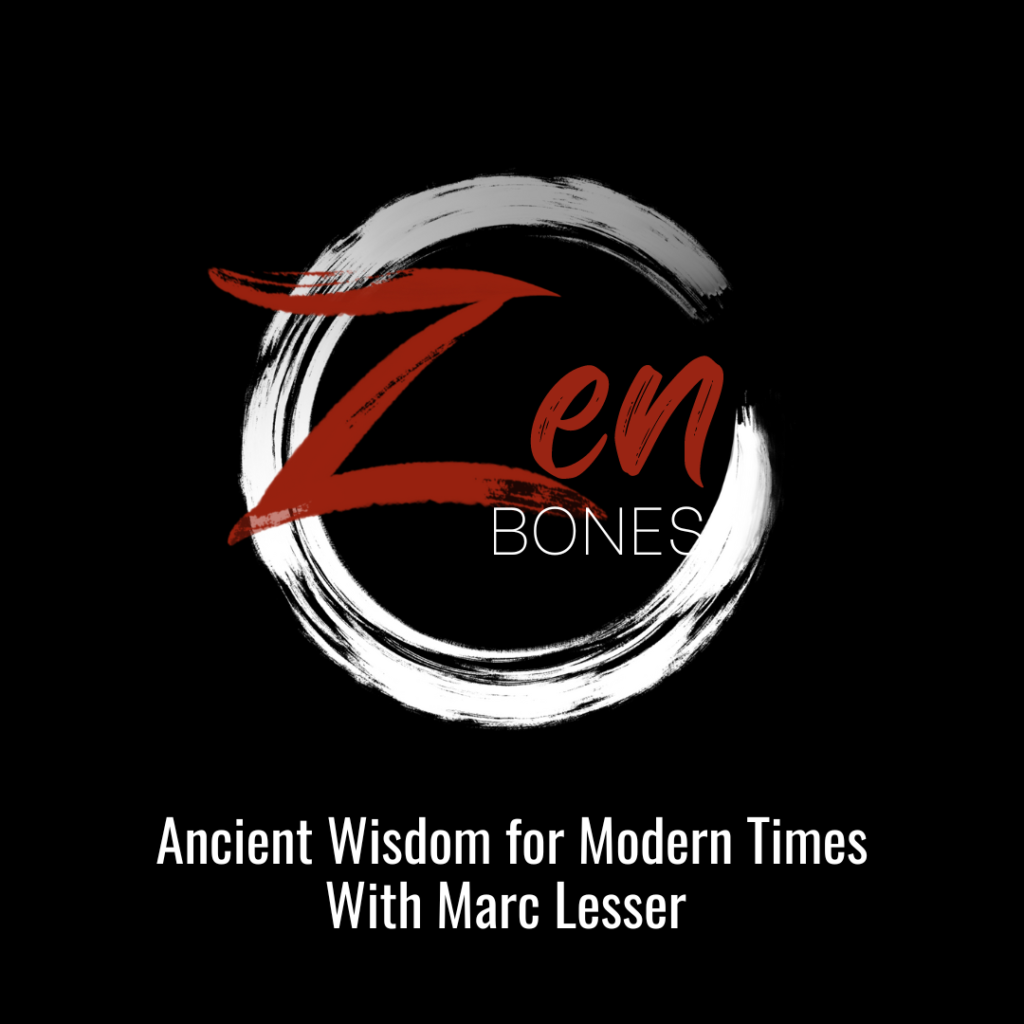In this Practice episode, Marc leads a short guided meditation followed by a talk on Change and the 3 Stages of Transition: 1) Pausing, 2) Letting Go, and 3) Re-emerging. He also shares a poem from Naomi Shihab Nye.
Today’s Zen puzzler is from a formal Zen koan: “What is Zen or what does it mean to be human?” The answer involves an exploration of what we can learn about our lives from trees.
EPISODE TRANSCRIPT
[music]
[00:00:02] Marc Lesser: Welcome to Zen Bones: Ancient Wisdom For Modern Times. This is Marc Lesser. Why Zen Bones? Our world is in crisis and ever-shifting, and now more than ever, more wisdom, clarity, and courage are essential, especially in the world of work, business, and leadership. In today’s episode called Embracing Transitions, we start with a short guided meditation utilizing this theme of transitions, pausing, letting go, and re-emerging. I then do a short talk on change and embracing transitions and unpack the three stages of transitions, endings, not knowing, and new beginnings. I share a poem from Naomi Shihab Nye about change and appreciating change.
Today’s Zen puzzler comes from a formal Zen Koan about the question what is Zen or what does it mean to be fully human, where the teacher responds about a cypress tree in the garden, and what can we learn from trees after all about our lives? I hope you enjoy this episode.
[music]
Well, let’s do some sitting practice together.
[music]
I hope that the bell can support us and help us to pause, noticing the body, noticing the breath, arriving, arriving. The transition from whatever you were doing to being more fully here and now. Arriving here. Zen teacher Thich Nhat Hanh says the real miracle isn’t to walk on water, the real miracle is to walk right here on earth. The real miracle is to be here, fully here, this body, this breath. Whether your mind is calm right now or not so calm, bouncing, just noticing, and using the breath and the body as a way to anchor, as a way to support us. The great gift. Seeing everything as gift.
The energy, the warmth coursing through us right now. Gravity allowing us to be here on this earth and this breath, the gift of this breath. Simply noticing, breathing in, and breathing out. The theme for this episode is around transitions, around change. Noticing the transition from whatever you were engaged in to stopping, pausing, allowing our big mind, big heart to be present, always with us, but somehow we don’t always notice. Part of the transition is ending whatever you were doing and entering this space of not knowing.
Right now, letting go of our usual expectations, judgments, criticisms, and what is it like to just be here. Checking in with the body. Noticing the breath. Letting thinking mind do its thing in thoughts, like clouds in the sky, and noticing whatever you are feeling right now. What is it like to be here? What is it like to be alive right now and cultivating some approach? The approach is curiosity, kindness, and warm-heartedness. Warmhearted approach to this transition.
Noticing this ordinary practice, and at the same time, something sacred, extraordinary about this life, this body, this breath. A childlike curiosity, that this breath, this time is new, is fresh. We don’t have to pretend it is so. It’s shifting from habit energy to the energy of more freedom. The freedom and courage to be here alive, not knowing what will happen next.
Then the other aspect of this model of transitions is emerging. Ending this particular time and emerging into whatever is next with a sense of learning, reinventing your life, not being caught by old old ghosts and patterns and habits. Bringing a sense of freshness. I’m going to reemerge right now as I ring the bell to end this sitting, but please feel free to join me or feel free to continue sitting.
[music]
Transitions and embracing transitions. We’re almost always in some kind of transition or maybe it might be more precise to say that we are always in transition. We always are in this living, on this edge of change and maybe there’s different images for how we live in time. One image is like living on the edge of a wave that’s breaking, that there’s this sense of now and the other image for time is that everything from our past, everything, even perhaps from our future is right here. Everything is right here and right now. The transitions. Some are enormous, like starting or ending a job or beginning or ending a relationship or a birth, a transition into adulthood, or a death.
Some transitions are more ordinary, like starting the day or beginning our work day or stopping or starting playing an instrument or a sport, or completing a project. I’m currently celebrating the transition of having recently completed a book called Finding Clarity and I’m noticing I’m both celebrating that it’s complete and I’m also grieving that it’s a project that was close to my heart for a long time but now beginning the new process of birthing the book out into the world with a sense of not knowing. I don’t know how this book will, how it will be received in the world.
Some transitions are inevitable, like the rhythms of starting and ending each day, a conversation or a period of meditation are kinds of transitions. Sometimes we bring great awareness to these changes, these transitions, and sometimes not so much. Some transitions we celebrate and others we resist. We can welcome them or we can appreciate them.
I recently stumbled upon a book that I remember really enjoying that was written, I think more than 40 years ago, is a book called Transitions by someone who I discovered lives here in Mill Valley, California. His name is William Bridges and he describes three stages of transitions. There’s a lot of different models, and I think models are extraordinarily useful. Mindfulness and Buddhism is a model.
Emotional intelligence is a model. We learn from models. The historical Buddha presented Buddhism as a model. Things like the foreign noble truths and the eightfold paths are models for how to live, how to shift our lives from habit energy to more freedom. I think this model of transition is also a useful model. The model that William Bridges describes is that looking at transitions as starting with endings.
What is it we are letting go of? When we wake up, our night of sleep is ending. When we begin a new job, we’re ending whatever we were doing previously. When we start a period of meditation, it may be the beginning of meditation, but it’s the ending of whatever we were doing. When someone dies, this is ending, some profound ending. Recognizing endings is I think a useful, practical, and powerful way to look at transitions.
How something is ending and letting go of a relationship, or a job, or a meditation. Ending. It’s a way of leaning into and allowing space for whatever might be happening next. Then Bridges describes the next part of transitions is what he calls the neutral zone. In Zen practice, we might call it not knowing, letting go of expectations. After ending is a state often of disorientation, sometimes confusion, but it’s also a state of openness. It can be beautifully uncomfortable. Again, sometimes painful. This is especially true in more major transitions like ending a relationship or ending a job, and often we resist or avoid this stage.
This is a stage that is uncomfortable, where we don’t know what will happen. As I was describing, I don’t know what will happen with this book that is about to be birthed in the world. In truth this is a super interesting stage. I think about where I am in relationship to my partner, to my children, to my work life. This place of not knowing. There’s great discomfort, but also great sense of freedom and possibility in acknowledging and embracing and allowing this stage. I remember several years ago when I left my role as CEO of the Search Inside Yourself Leadership Institute, it was painful. Even though it was my choice and I resigned, I really didn’t know what was next and I distinctly remember a phone call that I had with a friend and colleague John [unintelligible 00:17:53].
He strongly encouraged me to take my time and to allow myself to spend time and stay in this place of discomfort, of not knowing what I was going to do next in my career, in my work life. I really appreciated his advice, his support to stay with the discomfort and to allow it, not force it. Just let it take as long as it needed to take in. In some way, wonderful things have emerged in my own transition since leaving that role and in some way, I’m still in it.
I’m still in it always in some way transition. The third stage that is described in this particular model is new beginnings so it’s appreciating endings, allowing that place of the neutral zone or not knowing, and then emerging into new beginnings. This is the stage of putting our insights and understanding into play. Responding and acting. Stepping into this might be stepping into a new job, a new role, a new relationship. Sometimes it’s a new identity during larger major transitions.
Again, this is a model that can be applied to major shifts in our lives, or to the flow of transition of projects like writing a book or the transition of a day, or a period of meditation. To begin the ending, whatever we were previously doing, we stop, we pause, we enter a space of not knowing, a sense of letting go as much as possible. Then we get up and we enter the world new and fresh and altered. In this model, meditation practice can be hitting the refresh button of our lives. I think it’s especially useful, right? I get all these stages acknowledging endings not knowing and mining crafting whatever it is we’re learning.
This is very similar to a model that you may be familiar with that was popularized by a colleague of mine Otto Scharmer and his book Theory U. Here he describes the left side of the U is he calls it observing and noticing and sensing and then going down. The U to the bottom is again very similar to the neutral zone not knowing. Then coming up the right side of the U is reinventing, recreated our worlds.
Again whatever model works for you I think these are useful ways of discovering more freedom, transforming a sense of conditioning of habit energy into more freedom and more possibility in how we respond how we initiate, and ultimately in how we show up for our lives. I hope you can enjoy, appreciate, and embrace transitions. I want to read a poem that is about transitions. It’s a poem called Burning the Old Year by wonderful poet Naomi Shihab Nye.
Letters swallow themselves in seconds.
Notes friends tied to the doorknob,
transparent scarlet paper,
sizzle like moth wings,
marry the air.
So much of any year is flammable,
lists of vegetables, partial poems.
Orange swirling flame of days,
so little is a stone.
Where there was something and suddenly isn’t,
an absence shouts, celebrates, leaves a space.
I begin again with the smallest numbers.
Quick dance, shuffle of losses and leaves,
only the things I didn’t do
crackle after the blazing dies.
Beautiful poem and I really appreciate Naomi Shihab Nye’s poem about transitions.
[music]
Welcome to the Zen Bones puzzler where I will regularly be presenting a story or a Zen koan or a poem. Something to contemplate, to think about. A story that has purpose. It’s about developing greater insight and reflection. Not so much for a solution but as a way to support your practice, a kind of meditation in daily life.
[music]
Today’s Zen puzzler. I really like this. Zen koan, Zen puzzler trying to unpack them and apply them to how we can make them practical. At the same time, allow the mystery and not knowing of them to penetrate our lives. Today’s Zen puzzler is from a classic Zen koan, Zen story. It is about a monk that asks the famous Zen teacher Zhaozhou, What is the meaning of Zen? Zhaozhou famously replies in this particular Zen koan, the cypress tree in the yard. Some of these Zen stories are somewhat logical and some completely make no sense at all. This one on its surface looks like it makes no sense at all.
Looks like Zhaozhou is avoiding the question. What if he’s not? What if he’s actually giving us a variety of clues? Again, the way these koans are used in Zen practice is that we just stay with them right? What is the meaning of Zen? The cypress tree in the yard. What is the meaning of Zen? What are our lives ultimately about? How can we penetrate our lives? Of course, the question itself it’s an impossible deep question, right? What does it mean to be a human being? I think this is a great question. What does it mean to be human? What kind of human being do I want to be?
I don’t think we ask this question enough. It’s a question that I think I keep coming back to. What kind of human do I want to be? What kind of human do you want to be? Here, the cypress tree in the yard. The cypress tree is true and elegant and always changing. This cypress tree was at one point a seed is now this beautiful magnificent cypress tree in the yard shimmering alive. One day will die like all living things. In some way, this is a Zen story about transition. It’s a Zen story about meaning. It’s a Zen story that represents this impossible deep question. What is the meaning of Zen? What is it? What is the meaning of our lives?
I think suggestion is to stay with this question of what kind of human being do you want to be? The cypress tree in the yard. What can you learn from the cypress tree? Trees are amazing. I’m sitting here right now looking at some trees out the window. Just spectacular and mysterious. To think that they are alive and how much movement is happening in them that we can’t see.
The elegance and mystery and beauty of the cypress tree in the yard. This question of what kind of human do you want to be? You might explore reflecting on these questions in meditation practice or throughout the day or try journal writing. What kind of human do you want to be? What can I learn from any tree right now right here?
[music]
Listen in each week for interviews, teachings, and guided meditations. You’ll receive supportive tools for creating more meaningful work and mindfulness practices to develop yourself, to influence your organization, and to help change the world. Thank you for listening.
[00:29:59] [END OF AUDIO]









